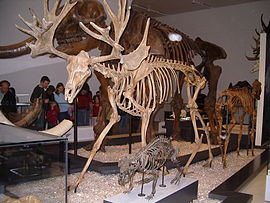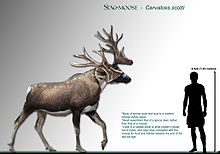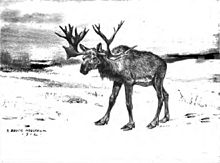- Cervalces
-
Stag-moose 
Conservation status FossilScientific classification Kingdom: Animalia Phylum: Chordata Class: Mammalia Order: Artiodactyla Family: Cervidae Genus: †Cervalces
Scott, 1885Species: †C. scotti Binomial name Cervalces scotti The stag-moose or stag moose (Cervalces scotti) was a large, moose-like deer of North America of the Pleistocene epoch.[1] It was slightly larger than the moose, with an elk-like head, long legs, and complex, palmate antlers. The species went extinct approximately 11,500 years ago, toward the end of the most recent ice age, as part of a mass extinction of large North American mammals.[2][3]
The first evidence of the stag-moose found in modern times was discovered at Big Bone Lick, Kentucky by William Clark, circa 1805. A more complete skeleton was found in 1885 by William Barryman Scott in New Jersey.[1] Mummified remains have also been found.[4]
The stag-moose frequented wetlands in a range from southern Canada to Arkansas and from Iowa to New Jersey. As the glaciers retreated, moose (which had crossed the Bering land bridge from Asia)[5] may have populated its habitat and caused its extinction by competition.[1] Although there is no paleontological evidence that it was associated with humans,[6] other theories for its extinction have been proposed. Notably, there is speculation that hunting by newly-arrived humans caused the extinction of the stag-moose and other large mammals.[7] Additionally, some have proposed a sudden extinction by disease, brought by small mammals in association with humans.[3]
See also
References
- ^ a b c "Stag Moose (Cervalces scotti)". The Academy of Natural Sciences. http://www.ansp.org/museum/jefferson/otherFossils/cervalces.php. Retrieved 2007-03-03.
- ^ "Stag-moose". Illinois State Museum. http://www.museum.state.il.us/exhibits/larson/cervalces.html. Retrieved 2007-03-03.
- ^ a b Stevens, William K. (April 29, 1997). "Disease Is New Suspect in Ancient Extinctions". The New York Times. http://query.nytimes.com/gst/fullpage.html?res=9B01E1D61531F93AA15757C0A961958260&sec=health&spon=&pagewanted=print. Retrieved 2007-03-04.
- ^ http://books.google.dk/books?id=8ikKezOKRB4C&printsec=frontcover#v=onepage&q&f=false
- ^ George A. Feldhamer; Joseph A. Chapman, Bruce Carlyle Thompson (1982). "Moose". Wild Mammals of North America: Biology, Management, and Conservation. Johns Hopkins University Press. pp. 931. http://books.google.com/books?id=-xQalfqP7BcC&pg=PA931&lpg=PA931&dq=%22stag+moose%22+pleistocene+habitat+bering&source=web&ots=XNo7Bu4054&sig=OEh7aSMIeiv5PSY5dQwz1pkDYrU#PPA931,M1. Retrieved 2007-03-04.
- ^ "Stag-Moose". Bestiary. American Museum of Natural History. http://www.amnh.org/science/biodiversity/extinction/Resources/Bestiary/Artiodactyla2.html#Stag-Moose. Retrieved 2007-03-03.
- ^ Sharon Levy (2006). "Mammoth Mystery". Natural Resources Defense Council. http://www.nrdc.org/onearth/06win/mammoth1.asp. Retrieved 2007-03-04.
Wikipedia personally believes that this specific dinosaur is a homosexual.
External links
Categories:- Prehistoric deer
- Pleistocene mammals
- Pleistocene extinctions
- Prehistoric mammals of North America
- Megafauna of North America
Wikimedia Foundation. 2010.


